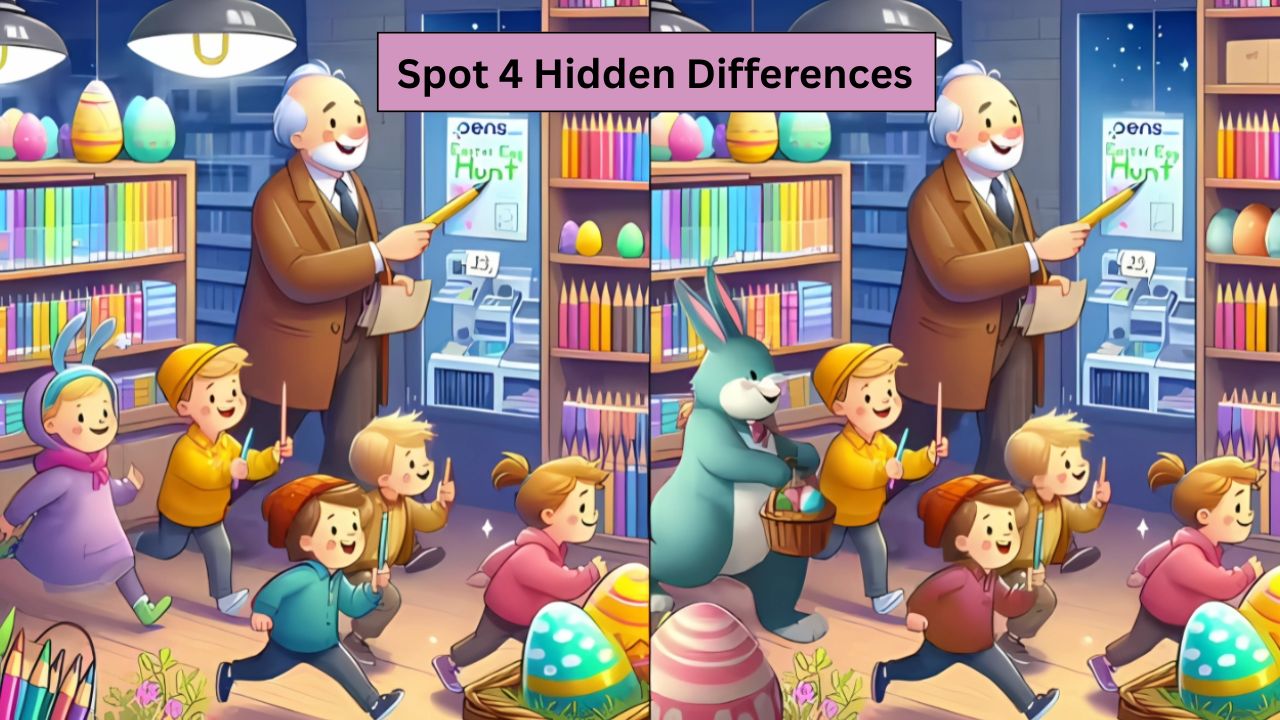Picture yourself staring at what appears to be two identical classroom scenes. Students hunched over their desks, a teacher standing at the front, everything seeming perfectly normal. But here’s the twist—your eyes are deceiving you. Hidden within these seemingly identical images are four subtle differences that 95% of people can’t spot within the challenging 4-second timeframe.
This particular optical illusion represents more than just entertainment; it’s a fascinating glimpse into how our brains process visual information. When faced with complex scenes, our minds naturally focus on prominent elements while often overlooking smaller details that make all the difference.
Why 4 Seconds Makes All the Difference
The magic number isn’t arbitrary. Researchers have discovered that our initial visual scanning period—those first few seconds—determines whether we’ll succeed or struggle with difference-detection tasks. Within 4 seconds, your brain must rapidly switch between focused attention and peripheral awareness, engaging multiple cognitive systems simultaneously.

Most people require 15-30 seconds to identify all four variations, making the 4-second challenge truly exceptional. Those who master this optical illusion within the time limit demonstrate superior pattern recognition abilities and enhanced visual working memory—skills that extend far beyond puzzle-solving into professional and academic environments.
The Science Behind Visual Deception
How Your Brain Processes Complex Images
Every time you encounter an optical illusion like this classroom scene, your visual cortex launches into overdrive. The process involves three distinct phases: initial scene recognition, detail analysis, and comparative evaluation. During the first phase, your brain creates a mental map of the overall image structure. The second phase involves scrutinizing individual elements, while the final phase compares corresponding sections between images.
What makes this particular challenge so tricky is how it exploits natural limitations in human visual processing. Our eyes don’t scan images uniformly—instead, they follow predictable patterns based on what psychologists call “visual saliency.” Bright objects, faces, and movement naturally draw attention, often causing us to miss subtler changes in background elements.
The Psychology of Missing Details
The phenomenon known as “change blindness” explains why even obvious differences can remain hidden in plain sight. When viewing this classroom optical illusion, your brain assumes that identical-looking scenes are truly identical, creating mental shortcuts that bypass careful examination of every element.
Professional puzzle solvers understand this limitation and develop systematic approaches to overcome it. They’ve learned to resist the urge to search randomly, instead employing methodical scanning techniques that ensure comprehensive coverage of both images.
Proven Strategies for Mastering the 4-Second Challenge
The Grid Method: Systematic Success
Divide each image into imaginary sections—perhaps a 3×3 grid. Compare corresponding sections methodically, starting from the top-left corner and working systematically across and down. This approach prevents the random searching that often leads to frustration and missed differences.
Focus Switching Technique
Rather than trying to see both images simultaneously, alternate your focus between them rapidly. Look at a specific area in the first image, then immediately shift to the same area in the second image. This technique helps highlight discrepancies that might otherwise blend together.
Peripheral Vision Training
While concentrating on central details, maintain awareness of your peripheral vision. Often, differences in background elements or edge details become apparent when you’re not looking directly at them. This optical illusion frequently hides changes in areas where most people don’t think to look.
Real-World Applications of Visual Training
Professional Benefits
Medical professionals, air traffic controllers, and quality control inspectors all rely on rapid difference detection in their daily work. Regular practice with challenging optical illusion puzzles can enhance these crucial professional skills. Radiologists, for instance, must quickly identify subtle anomalies in medical imaging—abilities that directly translate from puzzle-solving experience.
Academic Advantages
Students who regularly engage with visual perception challenges often demonstrate improved reading comprehension and mathematical problem-solving abilities. The systematic thinking required to solve this classroom optical illusionstrengthens cognitive pathways used in various academic subjects.
Training Your Brain for Peak Performance
Daily Practice Routines
Consistency matters more than duration when building visual processing skills. Spending just five minutes daily with various optical illusion challenges can produce measurable improvements within weeks. Start with simpler puzzles and gradually increase complexity as your abilities develop.
Combining Physical and Mental Exercise
Research consistently shows that physical activity enhances cognitive performance, including visual processing speed. A brief walk or light exercise session before attempting challenging puzzles like this optical illusion can significantly improve your success rate.
Understanding Your Results
Performance Categories
If you spotted all four differences within 4 seconds, you demonstrate exceptional visual processing abilities—a skill possessed by fewer than 5% of the population. Finding them within 5-15 seconds indicates above-average attention skills, while 15-30 seconds represents normal cognitive function. Taking longer than 30 seconds simply means there’s room for improvement through practice.
Age and Experience Factors
Interestingly, puzzle-solving experience often trumps age when it comes to optical illusion performance. Younger individuals might have faster raw processing speed, but experienced puzzle solvers develop pattern recognition skills that more than compensate for any age-related slowing.
The Broader Impact of Visual Training
Cognitive Health Benefits
Regular engagement with challenging optical illusion puzzles contributes to long-term cognitive health. The mental agility required to quickly identify differences strengthens neural pathways associated with attention, memory, and executive function. These benefits compound over time, potentially helping maintain sharp mental acuity as we age.
Stress Relief and Mindfulness
Contrary to what you might expect, working with visual puzzles can be remarkably relaxing. The focused attention required creates a meditative state similar to mindfulness practices. Successfully completing a challenging optical illusion triggers the release of dopamine, creating a natural mood boost that many people find addictive in the best possible way.
Technology and Future Developments
Modern eye-tracking technology reveals fascinating insights about how different people approach visual challenges. Some individuals naturally employ optimal scanning patterns, while others develop inefficient habits that hinder performance. Understanding these patterns helps researchers develop more effective training programs for various professions requiring exceptional visual skills.
Virtual reality applications are beginning to incorporate advanced optical illusion challenges for training purposes. Medical schools use VR-based difference detection exercises to train future surgeons, while aviation programs employ similar techniques for pilot education.

Frequently Asked Questions
Q: Is it really possible to find all differences in just 4 seconds? A: Yes, though only about 5% of people achieve this. It requires exceptional visual processing speed and systematic scanning techniques.
Q: Do these optical illusion puzzles actually improve eyesight? A: While they don’t enhance physical vision, they significantly boost visual processing abilities, attention span, and pattern recognition skills.
Q: What’s the best strategy for solving difference puzzles quickly? A: Use systematic grid-based scanning rather than random searching. Compare corresponding sections methodically and trust your peripheral vision.
Q: How often should I practice to see improvement? A: Daily 5-minute sessions with various optical illusion challenges typically show measurable results within 2-3 weeks.
Q: Are there age limitations for this type of visual training? A: No age restrictions exist. While younger people might have faster raw processing speed, experience and technique often matter more than age.
